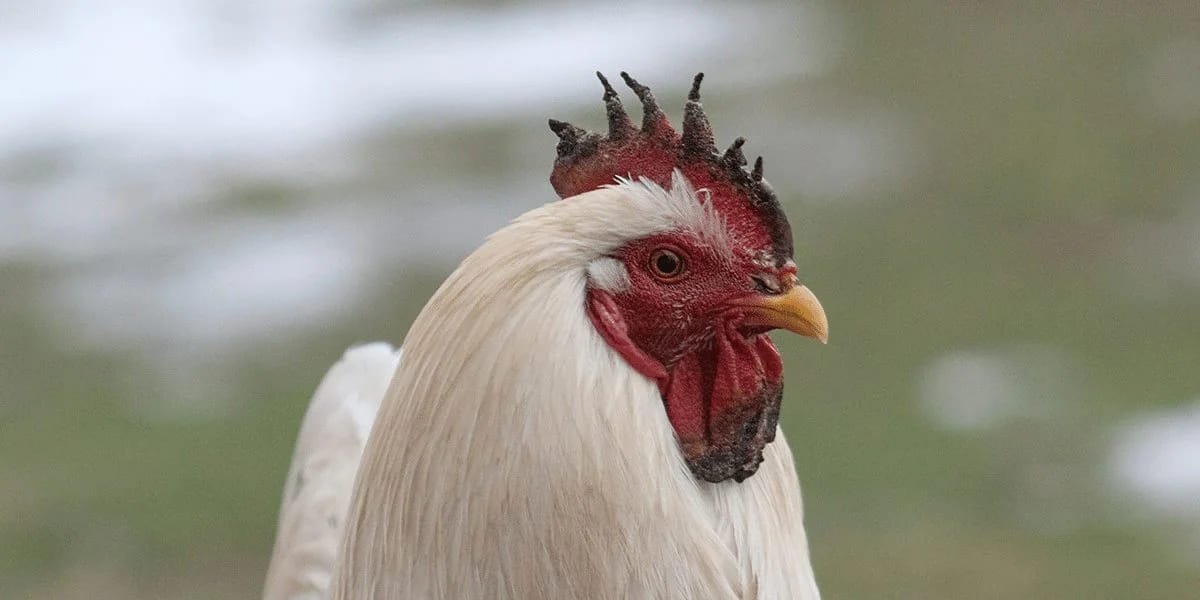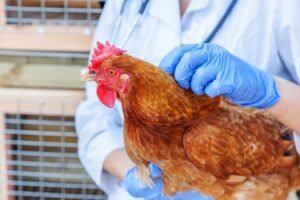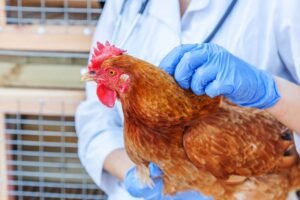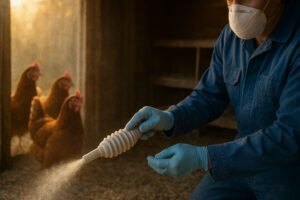Winter can be a beautiful time on the homestead, but for chicken keepers, it often comes with a unique worry: the health and safety of your flock in the cold. The most common cold-weather issue for poultry is frostbite, a painful and potentially dangerous condition that primarily affects the exposed fleshy parts of a chicken’s anatomy—the combs and wattles. If you’ve been wondering how to prevent and treat frostbite on chicken combs, you’ve come to the right place.
As a chicken keeper with several winters under my belt, I’ve learned that a proactive approach is always best. This guide will walk you through what frostbite is, what to look for, and a simple, effective strategy for prevention and care, so you can face the winter with confidence. Our goal is to empower you with the knowledge to keep your flock happy and healthy all winter long.
What Does Frostbite Look Like on a Rooster Comb and What Is It?
Understanding Frostbite: More Than Just Being Cold
Frostbite is basically tissue damage caused by freezing. It happens when moisture on a chicken’s comb or wattle freezes, and those tiny ice crystals cut off circulation to the area. The blood vessels tighten up, and the cells are damaged, which can even lead to permanent tissue loss. The biggest culprits are a combination of low temperatures, wind chill, and especially high moisture and humidity inside the coop. This is why a wet comb in a cold, windy coop is far more susceptible than a dry comb in an even colder, but dry, environment.
How to Tell if Your Chickens Have Frostbite: The Key Signs
Early detection is key, and there are a few tell-tale signs to look for. Pay close attention to your roosters, as their larger combs and wattles make them especially susceptible.
- Early Stages: The first thing you’ll notice is that the tips of the comb or wattles will look pale, grayish-white, or waxy. This is often the first visible sign of poor circulation. The tissue might feel cold to the touch but should still be soft and pliable.
- Advanced Stages: The affected areas will begin to swell and may develop blisters. As the tissue starts to die, it will turn a dark purple or black spots, and eventually become shrunken and hard. This discoloration is a sign of severe tissue damage. The blackened tissue is necrotic and will not recover.
- Behavioral Signs: Besides the physical signs, a chicken might also seem less active, be reluctant to eat or drink, or show signs of discomfort if its wattles are painful. You might even see them shaking their head or acting lethargic.
Recognizing the signs of frostbite is the first step, but preventing it is the most effective solution. Now let’s explore the ultimate prevention strategy, focusing on coop management and daily care.
How to Prevent Frostbite in Chickens: The Ultimate Prevention Strategy
The best way to treat frostbite on a chicken’s comb is to prevent it from ever happening in the first place! The key is focusing on the flock’s environment and health.
Your #1 Defense: A Dry, Well-Ventilated Coop
Your single most important defense against frostbite is a dry coop. Excess moisture from their droppings and respiration will freeze on their combs and wattles, making them highly vulnerable.
The Dangers of a Sealed Coop
It’s a common mistake to seal a coop completely to keep it warm, but this actually traps moisture and ammonia. This creates a breeding ground for harmful bacteria and frostbite, so proper ventilation is non-negotiable. To put this in perspective, the experts at The Featherbrain, a trusted online resource for poultry keepers, recommend that “the only ventilation you have in your coop is vents that are located well above your chickens’ heads and the pop door.” This ensures stale, moist air escapes without creating a dangerous drafts at the chickens’ level while they are sleeping on their roosting bars.
How to Insulate a Chicken Coop
While you might be tempted to load up on insulation to prevent hypothermia, it’s far more important to focus on moisture control. Excessive insulation can trap moisture, which is the main cause of frostbite. The key is to protect the birds from drafts and ensure they can get out of the wind. A chicken’s feathers are a natural insulator, and as long as they stay dry, they are excellent at keeping them warm.
The Great Debate: What Can I Put on My Chicken’s Comb to Prevent Frostbite?
One of the most common questions is about using protective balms.
Should I Put Vaseline on My Chicken’s Comb?
Many poultry keepers do use Vaseline as a protective barrier, but it’s crucial to understand how it works. It creates a moisture-resistant layer on the comb and wattles, which prevents moisture from settling and freezing on the skin. However, it is not an insulator and will not provide a significant amount of warmth. It can also be messy and attract dirt and other particles. It should be applied in the evening, after your birds have settled for the night, to avoid attracting debris during the day.
Are There Safer Alternatives? (Lanolin, Natural Balms)
Yes, many keepers prefer to use Lanolin or other poultry-safe balms. These are often thicker and more water-repellent than Vaseline, offering a more robust barrier. They are also non-toxic if ingested. For application, simply warm a small amount between your fingers and gently apply a thin, even layer to the comb and wattles, being careful not to rub.
Beyond protecting the combs and wattles, a holistic approach to your coop and your flock’s diet will give them the best chance to thrive. Let’s look at more ways to manage your coop and support your birds’ health.
Beyond the Comb: Protecting Feet and Toes
While combs and wattles are the most common frostbite sites, a chicken’s feet and toes are also highly susceptible to cold injury. This is especially true for breeds without feathered feet.
The Dangers of Walking on Cold Ground
A chicken’s feet are constantly exposed to cold, wet surfaces like snow, ice, and frozen ground. When a chicken stands on a roost or on the ground, the lack of an insulated barrier can quickly cause its feet to lose heat and freeze.
How to Protect Your Chickens’ Feet
You can protect your chickens’ feet by providing the right environment for them to roost and walk.
- Provide Flat, Wide Roosts: Instead of round bars, use a 2×4 with the wider side facing up. This allows the chicken to rest flat-footed, which enables them to cover their feet with their body feathers while roosting. As poultry expert Gail Damerow, author of The Chicken Health Handbook, explains, “Frostbitten toes are unlikely when the chickens have places to rest with their feet off a frozen surface. Roosts constructed from 2×4 lumber with the wide surface facing upward allow chickens to sleep with their feet covered by their bodies.” This simple change is one of the most effective methods for preventing frostbite on their toes at night.
- Create Dry, Snow-Free Zones: In their run, provide areas covered with a tarp or a lean-to so they have a place to scratch and forage that is protected from snow and ice.
- Deep Litter Method in the Coop: As mentioned earlier, a thick layer of dry bedding in the coop, managed with the deep litter method, provides insulation and a warm surface to stand on. The heat generated by the decomposing organic material can also help to warm the coop.
Your chickens’ diet is just as important as their environment for keeping them warm and healthy. Let’s delve into how proper nutrition and hydration can be your best allies this winter.
Fueling the “Feathered Furnace”: The Importance of Winter Nutrition
Proper nutrition is crucial in winter because a chicken’s metabolism is its internal furnace. To generate enough body heat to stay warm, they need the right fuel.
High-Energy and High-Protein Foods
In winter, chickens require a higher-energy diet to maintain their body temperature. According to the University of Minnesota Extension, chickens need more fuel to stay warm, so “Keep in mind that your flock’s feed intake may increase up to 25% during cold weather.”
- Offer Evening Treats: Give your flock a “nightcap” of high-energy foods right before they go to roost. Cracked corn is a popular choice because it takes longer to digest, which provides a slow-burning heat source that lasts through the night.
- Increase Protein: Protein is essential for feather health and overall body function. Consider supplementing their regular feed with high-protein treats like black oil sunflower seeds or mealworms. These not only provide energy but also encourage them to forage and stay active, which also helps with circulation.
- Warm Treats: Offering warm oatmeal or a “chicken soup” of cooked grains and vegetables on a cold morning is a great way to provide a quick energy boost and a comforting treat.
Consistent Access to Fresh, Unfrozen Water
This is arguably the most critical and often overlooked part of winter chicken keeping. A chicken will not eat if it cannot drink.
- Use a Heated Waterer: Investing in a heated waterer is the most reliable way to ensure your flock always has access to liquid water.
- Check Water Multiple Times a Day: If you don’t have a heated waterer, you will need to break up the ice and replace the water several times a day.
Despite your best efforts, frostbite can still happen. In the event you find a chicken with signs of frostbite, knowing how to respond is critical to their recovery. Let’s walk through the proper steps for frostbite on chicken comb treatment.
How to Treat Frostbite on a Rooster’s Wattles and Comb
If you discover a chicken with frostbite, it’s important to act quickly and cautiously.
CRITICAL SAFETY WARNING: Do NOT rub the affected area or try to re-warm it quickly, as this can cause even more damage. Rapidly warming the tissue can cause blood vessels to burst, leading to further necrosis. As the veterinary resource PoultryDVM.com advises, “Do not use direct heat (such as a hair dryer, heat lamp, or heating pads) to rewarm the affected area. Do not rub, massage, shake, or otherwise apply any physical force to frostbitten tissues, as it can cause more damage to the affected area.”
Step-by-Step Frostbite Treatment Guide
- Isolate and Gently Warm the Chicken. Bring the chicken to a warmer (but not hot) area, around 50-60°F (10-15°C). The goal is slow, gradual re-warming. This can be a garage, a spare room, or a secure area away from the main coop.
- Do Not Attempt to Treat Blisters or Blackened Areas. Do not pop blisters or apply salves to open sores. Leave the tissue alone and let nature take its course. Applying anything to compromised tissue can introduce bacteria and an infection.
- Provide Supportive Care. Ensure the bird has easy access to clean water and nutritious food. You can add electrolytes to the water to help with stress and recovery.
- Monitor for Infection. Keep a close eye on the affected area for signs of infection, such as pus, foul smells, or increased swelling.
Will Frostbite on a Rooster Comb Heal?
Yes, in most cases the black, dead tissue will dry up and eventually fall off on its own. This process can take several weeks or even months. The good news is that chickens can live a full, healthy life after losing parts of their comb or wattles. The new comb will often be smaller and less prone to frostbite in the future.
When to Consult a Veterinarian
You should seek veterinary help if the chicken shows signs of a systemic infection, stops eating or drinking, or seems to be in extreme pain. A vet can also prescribe pain medication or antibiotics if needed.
Here are a few more quick answers to common questions about frostbite and winterizing your flock.
Frequently Asked Questions (FAQ)
Can I use Vicks VapoRub on chickens?
No, you should not use Vicks VapoRub on chickens. The strong fumes and ingredients can be harmful to a chicken’s sensitive respiratory system, and it is not recommended for any use on poultry.
What about essential oils for frostbite?
Be very cautious with essential oils. Most are too strong for chickens and can cause irritation or other issues. It is best to stick to supportive care and approved balms unless directed otherwise by a veterinarian.
What about cold-hardy chicken breeds?
Some cold-hardy chicken breeds, like Wyandottes, Plymouth Rocks, and Orpingtons, have smaller combs and wattles, making them naturally more resistant to frostbite. However, even these breeds can get frostbite if their coop is wet and poorly ventilated.
Is a chicken with frostbite still good to eat?
This question can refer to two different things. If you mean a frozen chicken with freezer burn, which looks similar, the meat is safe to eat but the quality will be affected. If you are asking about a live chicken that has frostbite, the condition itself does not make the meat unsafe to eat, but you should focus on treating the bird.
Conclusion
By focusing on a dry, well-ventilated coop and proper management, you can drastically reduce the risk of frostbite for your flock. Remember that ventilation is more important than pure heat. While frostbite can be frightening, the knowledge of how to prevent and treat frostbite on chicken combs makes it a manageable challenge with proper, gentle care. Most importantly, a dry coop and consistent circulation are your best friends for winterizing your poultry.
Disclaimer: The information in this article is based on personal experience and research. It is not a substitute for professional veterinary advice. Please consult a qualified veterinarian for any serious health concerns.

Oladepo Babatunde is the founder of ChickenStarter.com. He is a backyard chicken keeper and educator who specializes in helping beginners raise healthy flocks, particularly in warm climates. His expertise comes from years of hands-on experience building coops, treating common chicken ailments, and solving flock management issues. His own happy hens are a testament to his methods, laying 25-30 eggs weekly.



